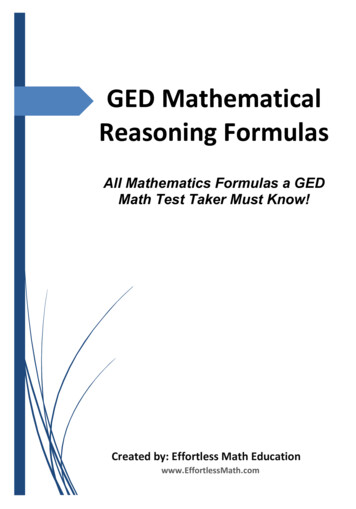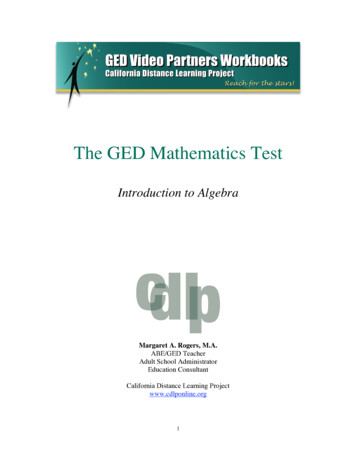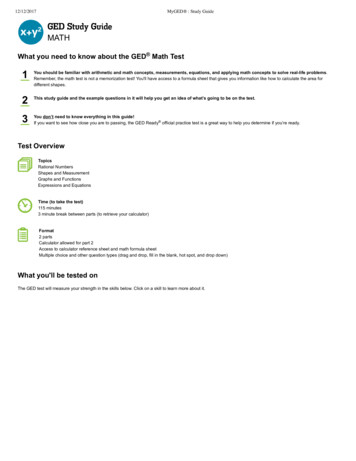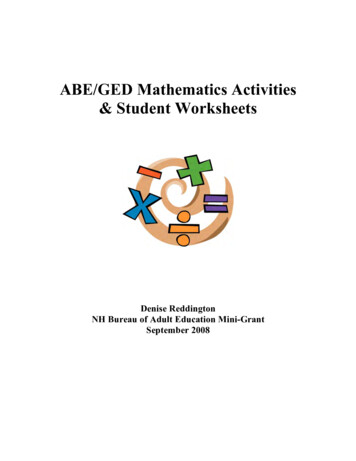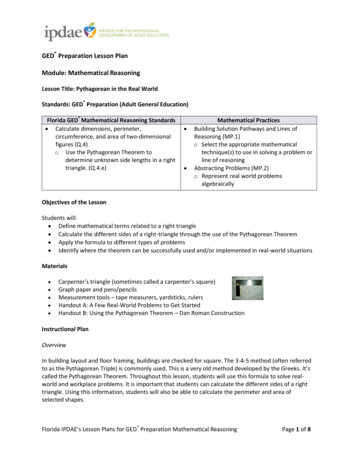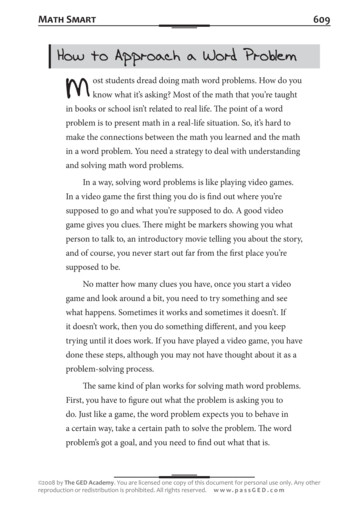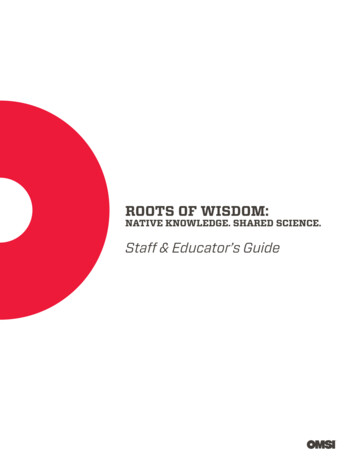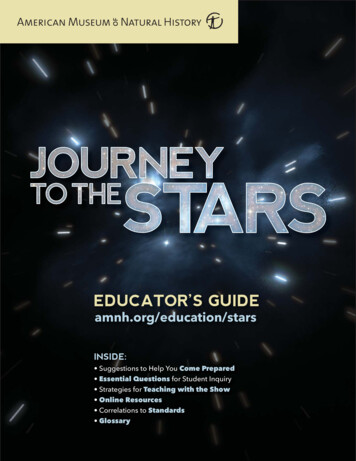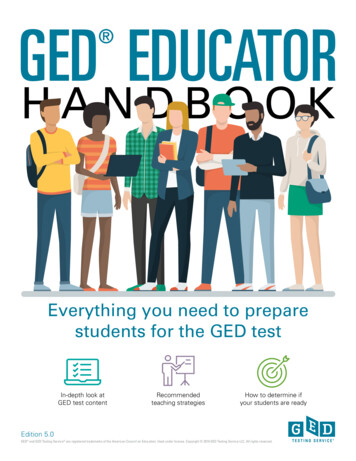
Transcription
GED EDUCATOR HANDBOOKEverything you need to preparestudents for the GED testIn-depth look atGED test contentRecommendedteaching strategiesHow to determine ifyour students are readyEdition 5.0GED and GED Testing Service are registered trademarks of the American Council on Education. Used under license. Copyright 2019 GED Testing Service LLC. All rights reserved.
GED Educator HandbookContentsNew Educator Checklist. . . . . . . . . . . . . . . . . . . . . . . . . . . . . . . . . . . . . . . . 5Chapter 1: The GED Test – A Closer Look . . . . . . . . . . . . . . . . . . . . . . . . . 7GED test basics . . . . . . . . . . . . . . . . . . . . . . . . . . . . . . . . . . . . . . . . . . . . . . . . . . . . . 7GED test benefits . . . . . . . . . . . . . . . . . . . . . . . . . . . . . . . . . . . . . . . . . . . . . . . . . . . 8What’s on the Reasoning Through Language Arts (RLA) test . . . . . . . . . . . . . . . . . . 8What’s on the Mathematical Reasoning test . . . . . . . . . . . . . . . . . . . . . . . . . . . . . . 9What’s on the Science test . . . . . . . . . . . . . . . . . . . . . . . . . . . . . . . . . . . . . . . . . . . . 9What’s on the Social Studies test . . . . . . . . . . . . . . . . . . . . . . . . . . . . . . . . . . . . . . 10Chapter 2: What Scores Look Like . . . . . . . . . . . . . . . . . . . . . . . . . . . . . . 11My Scores . . . . . . . . . . . . . . . . . . . . . . . . . . . . . . . . . . . . . . . . . . . . . . . . . . . . . . . . 11How I Can Score Higher (Personal Study Plan) . . . . . . . . . . . . . . . . . . . . . . . . . . . . 12What My Score Means . . . . . . . . . . . . . . . . . . . . . . . . . . . . . . . . . . . . . . . . . . . . . . 12My Written Answers. . . . . . . . . . . . . . . . . . . . . . . . . . . . . . . . . . . . . . . . . . . . . . . . . 12Chapter 3: Strategies for Teaching the Test. . . . . . . . . . . . . . . . . . . . . . . 13Use Performance Level Descriptors . . . . . . . . . . . . . . . . . . . . . . . . . . . . . . . . . . . . 14Focus on the skills that have the biggest impact. . . . . . . . . . . . . . . . . . . . . . . . . . . 15Prepare your students with test-day tools. . . . . . . . . . . . . . . . . . . . . . . . . . . . . . . . 15Help students write high-scoring RLA extended responses . . . . . . . . . . . . . . . . . . 16Share the basic rules for writing the RLA extended response. . . . . . . . . . . . . . . . . 17Give students feedback on their GED Ready constructed responses . . . . . . . . . . . 18Help organize math problems . . . . . . . . . . . . . . . . . . . . . . . . . . . . . . . . . . . . . . . . . 19Watch GED Testing Service webinars . . . . . . . . . . . . . . . . . . . . . . . . . . . . . . . . . . . 19GED.com GED.com/educator handbook3
GED Educator HandbookChapter 4: See If Your Students Are Ready. . . . . . . . . . . . . . . . . . . . . . . 21How GED Ready predicts test performance . . . . . . . . . . . . . . . . . . . . . . . . . . . . . . 21What GED Ready practice test scores mean . . . . . . . . . . . . . . . . . . . . . . . . . . . . . 22How to use the personal study plan . . . . . . . . . . . . . . . . . . . . . . . . . . . . . . . . . . . . 23What to do if a student doesn’t pass . . . . . . . . . . . . . . . . . . . . . . . . . . . . . . . . . . . 234GED.com GED.com/educator handbook
GED Educator HandbookNew Educator ChecklistIf you are new to teaching the GED test, here’s a checklist to help you get started.1. First, familiarize yourself with some of the basics of the test and make sure you arereceiving our latest updates. Sign up for our monthly newsletter, In Session, to get test updates, helpfulresources and program news. Look through our student study guides. These provide an overview of the skillsbeing tested and include sample problems for each skill.2. Once you know the basics, now it is time to better understand the studentexperience in GED.com. Feel free to create your own account in GED.com so you understand whatyour students will go through (please list your last name as “Candidate” so weknow you are an instructor). Take the free practice test so you understand the format of the test and thedifferent types of questions. Finally, consider taking a GED Ready test, the official GED practice test. Thisis half the length of the GED test and is highly predictive of how students willperform on the actual test.—— Make sure you review your detailed score report. This is the report thattells students the areas they need to work on to score higher on the test.—— Notice that they can select their study materials from the dropdown boxto create a customized study plan.3. After becoming familiar with the student journey, it’s time to apply for GEDManager, a free tool designed for adult educators where you can see your students’scores and score reports. Apply for access via the Educators section of GED.com. Each state hasdifferent rules on who can gain access. Once you get access, watch our training on how to effectively use the tool.GED.com GED.com/educator handbook5
GED Educator HandbookExplore these additional tools and resources to help you prepare your students.Tutorials and scoring tools Writing on the GED test—— Watch our helpful videos on how to write a great essay on the GED testand share with your students.—— To grade a student’s GED Ready essay, use our free scoring tool. Math—— Calculator tutorial—— Calculator reference guide and formula sheetHow To Guides Testing Guidance for Educators Transcript and Diploma Guidance for GED CredentialingMore information on the GED test and CCRS content Performance Level Descriptors — These are the skills that are measured onthe GED test. Assessment Guide for Educators — An in-depth guide to the GED test. High Impact Indicators —- Not all skills are created equal! Improving certainskills can help students improve in other areas. These resources providedetailed guidance on how you can best help improve student performance. College and Career Readiness Standards for Adult Education from OCTAEProfessional DevelopmentFor free professional development take a look at our webinar training series, Tuesdaysfor Teachers. There are over 30 trainings you can view.6GED.com GED.com/educator handbook
GED Educator HandbookChapter 1: The GED Test – A Closer LookThe GED test was built from the ground up to provide students a test that measures theskills they need to succeed. The test focuses on the foundational knowledge and skillsneeded for college and career readiness; colleges and employers can be confident thatstudents who pass the GED test have the skills to excel on the job or in the classroom.Keep reading to learn more about the GED test, including: GED test basics GED test benefits What’s on the Reasoning Through Language Arts test What’s on the Mathematical Reasoning test What’s on the Science test What’s on the Social Studies testGED test basics 4 test subjects: Reasoning Through Language Arts (RLA), MathematicalReasoning, Science, and Social Studies Students must score at least 145 in all 4 test subjects to earn their GEDcredential Students don’t have to take all 4 tests at once Delivered on computer Available in both English and Spanish 1 Extended Response question on the RLA test Offers three passing levels:—— GED Passing Score (score of 145-164)—— GED College Ready (score of 165-174)—— GED College Ready Credit (score of 175-200) Passing levels are based on the performance of high school graduates whotook the test as part of the standardization and norming study Scores reported in the Enhanced Score Report, available in student’s GED accountGED.com GED.com/educator handbook7
GED Educator HandbookGED test benefits Accommodations are free of charge, such as extra time and a paper test option Pay-as-you-go pricing allows students to pay for each test subject as they takeit in order to spread out the cost of the entire test Scores are available within one day of taking the test 100% refund if a test is canceled or rescheduled at least 24 hours before theappointment time Most students get 20 off of two retakes per subject through the discountedretake program*What’s on the Reasoning Through Language Arts (RLA) test 150 minutes (including a 10-minute break) Includes multiple choice, drop-down, and a variety of technology-enhanceditems Includes one 45-minute extended response (essay) Stimulus passages are 75% informational, 25% literary Passages are from 400 to 900 words long; they range in complexity, includingtext at the college and career readiness level Vocabulary focuses on words that appear frequently in a wide variety ofdisciplines Measures the student’s:—— Ability to read closely, write clearly, edit and understand written English—— Ability to understand, interpret, and answer questions based on text—— Ability to use evidence to support an argument—— Understanding of basic English skills at a level needed to succeed incollege or a job* Through the Discounted Retake Program, every candidate is eligible for two discounted retakes for a failedattempt on a GED test subject. These discounted retakes are valid for twelve months after the initial subject areatest attempt. For each discounted retake, GED Testing Service waives all testing fees, so the only costs to thestudent are any applicable state or testing center fees. This applies to U.S. test takers only. International studentsare not eligible.8GED.com GED.com/educator handbook
GED Educator HandbookWhat’s on the Mathematical Reasoning test 115 minutes 2 parts—— No calculator allowed on the first section—— Students may use a TI-30XS calculator or the built-in virtual calculator forthe remaining questions* Includes multiple choice, drop-down, and a variety of technology-enhanceditems A calculator guide and a math formula sheet are provided in the testing centerand on the screen Measures the student’s:—— Algebraic problem-solving abilities (55%)—— Quantitative problem-solving abilities (45%)What’s on the Science test 90 minutes No break Includes multiple choice, drop-down, and a variety of technology-enhanceditems Students may use a TI-30XS calculator or the built-in virtual calculator* Measures the student’s scientific reasoning skills in three areas:—— Reading and writing in science (30%)—— Science concepts (40%)—— Mathematical reasoning in science(30%)% 5545These skills apply to real%world situationsQuantitativein the context of the three science contentAlgebraictopics%20Earth &Space40%%40PhysicalScienceLife Science* International students may only use the virtual calculator.GED.com GED.com/educator handbook%15Geography9
GED Educator HandbookWhat’s on the Social Studies test 70 minutes No break SpaceIncludes multiple choice, drop-down, and a variety of technology-enhanced%items% 45Quantitative55Students may use a TI-30XS calculator orAlgebraicthe built-in virtual calculator* Measures the student’s reasoning skills in three areas:%20Earth &40%Life Science—— Reading and writing in Social Studies (33%)—— Social Studies concepts (33%)—— Mathematical reasoning in Social Studies(33%) These skills are applied to real world situationsin the context of the four content topics%15Geography%15Economics%50Civics & Govt20%U.S. History* International students may only use the virtual calculator.10GED.com GED.com/educator handbook%40PhysicalScience
GED Educator HandbookChapter 2: What Scores Look LikeStudents who take the GED test will get their test scores in their GED.com accounts.All students receive an Enhanced Score Report under the “My Scores” section thatincludes four parts: My Scores How I Can Score Higher (Personal Study Plan) What My Score Means My Written AnswersMy ScoresThis section looks slightly different depending on whether the score is for the GED testor the GED Ready practice test because they have different score levels. The GED testscore levels are: * Below Passing (score of 100 – 144) — Students who earned a below passingscore did not demonstrate the skills graduating high school seniors need toearn their high school diploma. GED Passing Score (score of 145 – 164) — Students who earned the GEDPassing Score demonstrated the skills that graduating high school seniorsneed to earn their diploma. GED College Ready (score of 165 – 174) — Students who earned the GEDCollege Ready score demonstrated the skills that graduating high schoolseniors need to earn their diploma at a level indicating college and careerreadiness. GED College Ready Credit (score of 175 – 200) — The highest scorepossible on the GED test. Students who earned the GED College Ready Credit score not only demonstrated the skills that graduating high schoolseniors need to earn their diploma at a level indicating college and careerreadiness, but they may be eligible for up to 10 college credit hours to apply totheir program of study (3 credits for math, 3 credits for science, 3 credits forsocial studies, 1 credit for language arts).* More information about the GED Ready score levels is available in Chapter 4.GED.com GED.com/educator handbook11
GED Educator HandbookGED Test ScoresHow I Can Score Higher (Personal Study Plan)Students who didn’t pass or who want to try for a higher score should use the personalstudy plan in the score report. The recommendations are based on their uniqueperformance on each GED test. See what skills they need to work on to score higher Select their favorite study materials to get a personal study plan with pagesand chapters to reviewWhat My Score MeansThis section describes all the skills that the student successfully demonstrated on thetest. These are strengths to build on in future learning and describe what the studentknows and can do based on their GED test results.My Written AnswersThis section displays different information on students’ responses depending onwhether the score report is for the GED test or GED Ready practice test.* GED test — Shows the students’ scores for their responses and the skillsthey need to work on to score higher on the RLA test. GED Ready practice test — Displays the student’s written responses toextended response. Educators can use the constructed response scoring toolsto give test-takers feedback on their responses.* More information about the GED Ready score report is available in Chapter 4.12GED.com GED.com/educator handbook
GED Educator HandbookChapter 3:Strategies for Teaching the TestYour students rely on you to teach them the skills and knowledge they need to pass theGED test. Here are some teaching strategies to help your students develop those skillsas they prepare for the test: Use Performance Level Descriptors Focus on the skills that have the biggest impact Prepare your students with test-day tools Help students write high-scoring extended responses Share the basic rules for writing an extended response Give students feedback on their GED Ready constructed responses Help organize math problems Watch GED Testing Service webinarsGED.com GED.com/educator handbook13
GED Educator HandbookUse Performance Level DescriptorsThe Performance Level Descriptors (PLDs) explain the skills students must demonstrateto score in each of the three possible performance levels on the GED test and the GEDReady practice test. Here are some helpful tips for using the PLDs in your classroom toprepare your students for the test:Tip 1: Use PLDs to assess your student’s current skill level Identify where to focus in order to develop the skills needed to move to thenext performance levelTip 2: Use PLDs to determine when your students are ready to test Determine if a student should take the GED Ready practice test or the GEDtest Use with the Enhanced Score Report’s personal study plan to developstudent skillsTip 3: Use PLDs to shape learning activities Set learning objectives in your classroom based on the PLDs Determine if you need to adjust how you’re approaching the content Work one-on-one with students to help develop necessary skillsTip 4: Use PLDs to add perspective to lesson plans14 Determine your students’ levels of preparedness and create lesson plansaccordingly Identify the gaps in your students’ skills and develop focused lesson plansto address those gapsGED.com GED.com/educator handbook
GED Educator HandbookFocus on the skills that have the biggest impactMake the most of instructional time with your students by focusing on the skills thatwill have the biggest impact on their GED test success.While all the indicators listed in the GED Assessment Target indicators are essential fortest-taker success, it may be useful for educators to highlight the skills from the HighImpact Indicators in their instruction.Be sure to also look at the Relationships Between the High Impact Indicators andOther Indicators. This tool shows the relationships between the High Impact Indicatorsand other indicators covered on the GED test. Use this resource to maximize theeffectiveness of your teaching lessons by covering skill sets for multiple test subjects atthe same time!Prepare your students with test-day toolsIt’s just as important for students to know how to use the tools available to them duringthe test. Use these tools in your classrooms so they are prepared on test day.Five Tools To Make Sure Students See Before Test Day The Computer-Based Testing Tutorial is a hands-on tutorial that showsstudents what the computer-based test will look like and walks themthrough the test’s functionality and features. Every student shouldcomplete the tutorial before taking the GED test in order to know how touse the test interface and know what to expect on test day. Extended Response Answer Guidelines include recommendations forstudents when crafting their RLA extended response and the criteria thatare used in scoring the response. Calculator Reference Sheet features instructions for using the on-screenTI-30XS calculator allowed on the Mathematical Reasoning, Social Studies,and Science tests. Math Formula Sheet and Explanations offers a list of formulas studentscan reference when taking the test. Sample Erasable Note Boards are available so students can practice withthese tools for test day. You can order these for your classroom throughGED PrintHub.GED.com GED.com/educator handbook15
GED Educator HandbookHelp students write high-scoring RLA extended responsesDuring the scoring process, some items are weighted more heavily than others. Theextended response item makes up about 20% of the student’s score. We recommendthat all students answer this item. There are no score deductions for incorrect answers.Make sure your students are prepared to craft fully developed responses. Use theSample Extended Response Passages and Prompts for Classroom Practice to gaugeyour students’ writing skills and give them feedback for improvement.Use these Steps for Drafting an Extended Response to guide your students througheach stage of this process.Steps for Drafting an Extended Response1. Read the passage and question.2. Unpack the prompt (identify key words including the verbs and actionrequired).3. Rewrite the question and turn the question into a thesis statement.4. Collect relevant details from the passage.5. Organize details into a logical order. Use a graphic organizer if that helps.6. Draft an answer.7. Re-read and edit/revise the answer making sure all parts of the questionare answered.16GED.com GED.com/educator handbook
GED Educator HandbookShare the basic rules for writing the RLA extended responseSimply attempting a written response on the RLA test subject doesn’t mean a studentwill earn points. Responses must meet the minimum scoring criteria, which you canfind in the Extended Response Resource Guide for Adult Educators. Also, make sureyour students follow these basic but important rules so they’ll maximize the points theyea
GED College Ready (score of 165 – 174) — Students who earned the GED College Ready score demonstrated the skills that graduating high school seniors need to earn their diploma at a level indicating college and career readiness. GED College Ready Credit (score of
